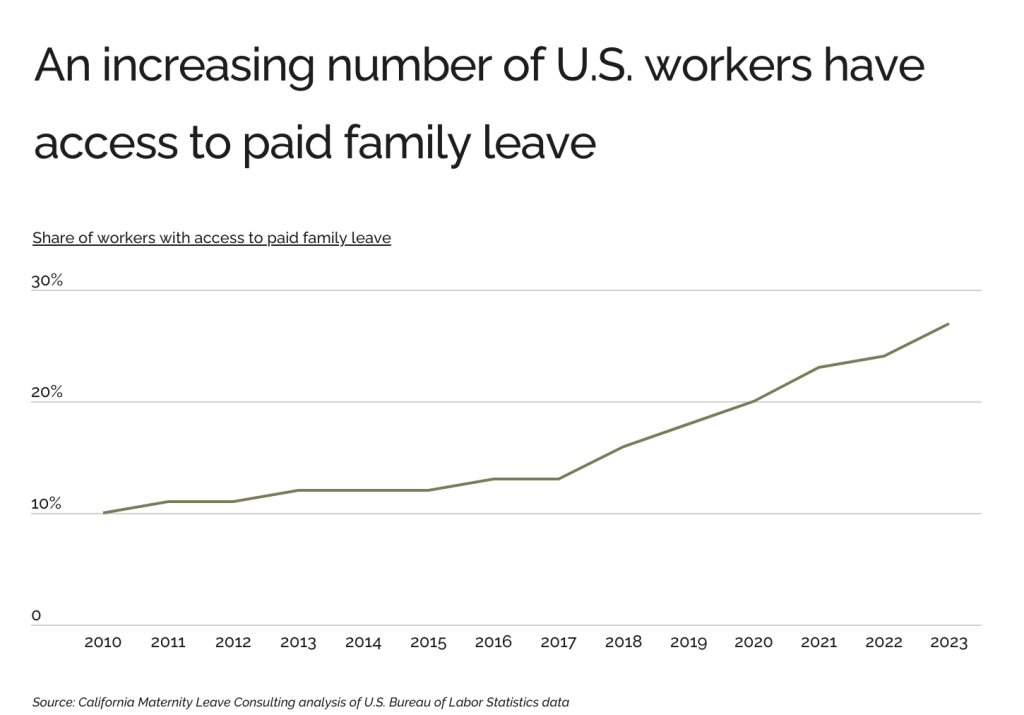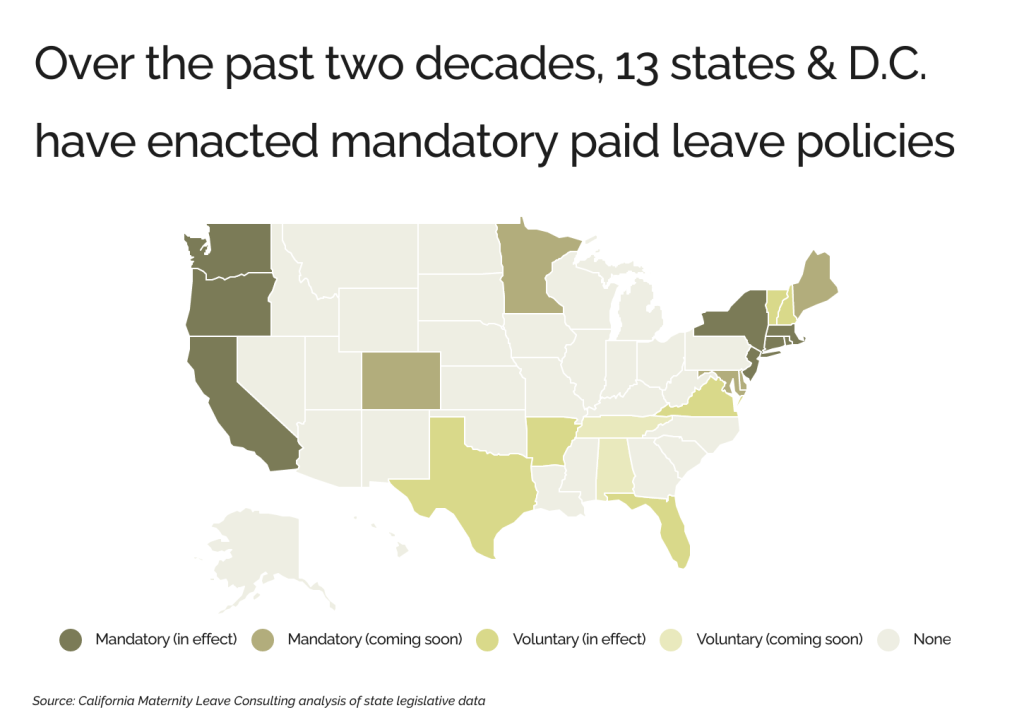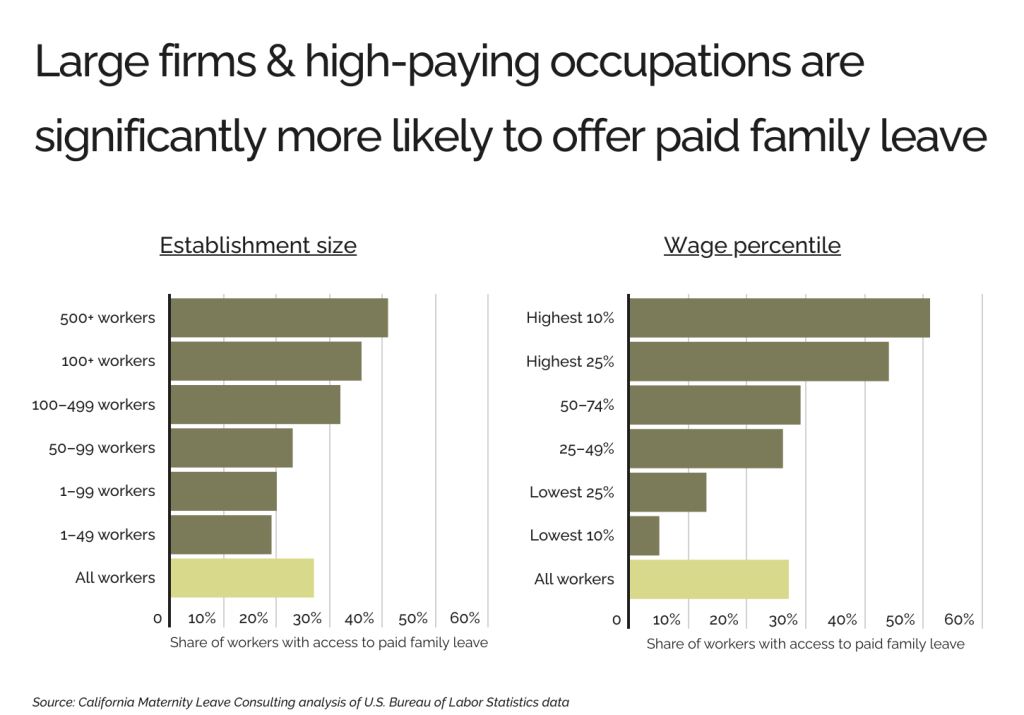While the onset of the COVID-19 pandemic led many women to temporarily leave the workforce, the years since have seen important gains for working women. The labor force participation rate for women has recovered to pre-pandemic levels faster than that for men, and recent growth has been particularly strong among prime-age women and the mothers of young children.
Aiding women and mothers’ return to the workforce has been the rise of flexible working arrangements in the wake of the pandemic. Further, tight labor markets in the past few years have led more employers to raise wages and provide expanded benefits in ways that have boosted women’s economic positions.
One of the most important benefits for working women is maternity leave. Unfortunately, the U.S. offers among the least generous parental leave policies of any nation. The primary form of leave available to most Americans is provided through the Family Medical Leave Act of 1993, which provides for up to 12 weeks of unpaid leave in a 12-month period. However, not all employers are required to provide FMLA leave, and not all workers are eligible. As a result, only around half of working women are FMLA eligible—and the fact that the leave is unpaid makes it difficult for many workers to use it fully.

While there are few guaranteed protections for new parents at the federal level, some progress has been made in the private sector and, increasingly, through state and local policy change. Many private sector employers have come to recognize that offering paid parental leave and other benefits for new or expecting parents is helpful for recruiting and retaining talent. Advocates for paid leave laws have pointed to increased family economic stability and improved infant and maternal health outcomes to encourage more jurisdictions to adopt leave requirements.
Efforts to expand access to paid family leave in the U.S. have been highly successful in recent years. Since 2010, the share of workers in the U.S. with access to paid family leave has nearly tripled, from 10% to 27%. That share has more than doubled just since 2017, when 13% of workers had access to paid family leave.

One of the major reasons for recent growth in access to paid family leave is that more states have begun to adopt laws requiring employers to provide paid leave funded through payroll deductions or establishing voluntary private insurance. A total of 13 states and the District of Columbia have implemented or passed some form of mandatory paid family leave law over the past few decades. An additional eight states have adopted voluntary paid leave programs.
The oldest of the mandatory programs was enacted in California in 2002, where employees are eligible for up to eight weeks of paid parental leave in addition to up to 51 weeks of pay for disabilities associated with pregnancy, childbirth and postpartum. With more than 19 million Californians in the civilian labor force, the state’s adoption of a mandatory paid leave program provided a major boost for access to paid leave in the U.S. Approximately 26,000 Californians file for paid family leave each month, receiving an average benefit of around $850 per week

While the federal government and the majority of states have yet to adopt paid leave requirements like those that exist in California, many private employers have voluntarily elected to provide paid leave as a benefit for their workers. Firms like Netflix—which offers a full 52 weeks of paid leave—and Amazon—which allows employees to share their paid leave with their partners—have gained recognition for their generous policies. However, access to private paid leave is distributed unevenly across the population. Larger firms are most likely to offer paid family leave as a benefit, and workers in the highest wage percentiles are most likely to have access.
Paid leave is an important and oft-discussed benefit for new mothers, but it is hardly the only benefit that matters for the caregivers of young children. Other offerings like flexible schedules, remote work, paid time off, and strong insurance options are also critical for ensuring that parents can balance their work and caregiving obligations. But as with paid leave, access to these other benefits can vary widely by employer and industry.
To determine the industries offering the best maternity benefits, researchers at California Maternity Leave Consulting analyzed the latest data from the U.S. Bureau of Labor Statistics. The researchers created a composite index based on the following factors for private-industry workers:
- Percentage of workers with access to paid family leave
- Percentage of workers with flexible workplace options
- Percentage of workers with access to short-term disability insurance
- Percentage of workers with access to long-term disability insurance
- Percentage of workers with access to wellness programs
- Percentage of workers with flexible schedule options
- Percentage of workers with paid vacation days
Here are the industries with the best benefits for expecting moms.
Industries Offering the Best Benefits for Expecting Moms

Photo Credit: Monkey Business Images / Shutterstock
14. Accommodation & food services
- Composite index: 4.4
- Share of workers with access to paid family leave: 7.0%
- Share of workers with flexible workplace options: 0.0%
- Share of workers with access to short-term disability insurance: 19.0%
- Share of workers with access to long-term disability insurance: 4.0%
- Share of workers with access to wellness programs: 19.0%
- Share of workers with flexible schedule options: 10.0%
- Share of workers with paid vacation days: 40.0%
The accommodation and food services sector comprises establishments providing customers with lodging and/or preparing meals, snacks, and beverages for immediate consumption. Common occupations among this industry sector include: cooks, waiters and waitresses, and lodging managers.

Photo Credit: BalanceFormCreative / Shutterstock
13. Construction
- Composite index: 17.6
- Share of workers with access to paid family leave: 16.0%
- Share of workers with flexible workplace options: 3.0%
- Share of workers with access to short-term disability insurance: 29.0%
- Share of workers with access to long-term disability insurance: 23.0%
- Share of workers with access to wellness programs: 21.0%
- Share of workers with flexible schedule options: 5.0%
- Share of workers with paid vacation days: 81.0%
The construction sector encompasses businesses involved in constructing buildings, engineering projects, site preparation, and land subdivision. This industry employs many different skilled labor occupations such as: carpenters, electricians, and construction equipment operators.

Photo Credit: ALPA PROD / Shutterstock
12. Retail trade
- Composite index: 22.0
- Share of workers with access to paid family leave: 27.0%
- Share of workers with flexible workplace options: 1.0%
- Share of workers with access to short-term disability insurance: 36.0%
- Share of workers with access to long-term disability insurance: 14.0%
- Share of workers with access to wellness programs: 44.0%
- Share of workers with flexible schedule options: 7.0%
- Share of workers with paid vacation days: 72.0%
Retail trade includes businesses that sell merchandise and offer related services, with two main types of retailers: store retailers, which have physical locations and use advertising to attract customers, and nonstore retailers, which use door-to-door solicitation, infomercials, and other means to market merchandise to the general public.

Photo Credit: Monkey Business Images / Shutterstock
11. Administrative & support services
- Composite index: 24.2
- Share of workers with access to paid family leave: 19.0%
- Share of workers with flexible workplace options: 9.0%
- Share of workers with access to short-term disability insurance: 30.0%
- Share of workers with access to long-term disability insurance: 14.0%
- Share of workers with access to wellness programs: 17.0%
- Share of workers with flexible schedule options: 12.0%
- Share of workers with paid vacation days: 66.0%
This broad sector includes businesses that perform routine support activities for the day-to-day operations of other organizations. Some activities performed include office administration, personnel hiring, clerical services, and waste disposal services among many others.

Photo Credit: Drazen Zigic / Shutterstock
10. Transportation & warehousing
- Composite index: 29.7
- Share of workers with access to paid family leave: 9.0%
- Share of workers with flexible workplace options: 0.0%
- Share of workers with access to short-term disability insurance: 52.0%
- Share of workers with access to long-term disability insurance: 34.0%
- Share of workers with access to wellness programs: 50.0%
- Share of workers with flexible schedule options: 3.0%
- Share of workers with paid vacation days: 90.0%
The transportation and warehousing industry sector comprises businesses involved in passenger and cargo transportation, warehousing, and scenic and sightseeing transportation. The industry employs workers such as airline pilots, bus drivers, and sailors among others.

Photo Credit: EHStockphoto / Shutterstock
9. Real estate & leasing
- Composite index: 39.6
- Share of workers with access to paid family leave: 17.0%
- Share of workers with flexible workplace options: 9.0%
- Share of workers with access to short-term disability insurance: 39.0%
- Share of workers with access to long-term disability insurance: 27.0%
- Share of workers with access to wellness programs: 29.0%
- Share of workers with flexible schedule options: 13.0%
- Share of workers with paid vacation days: 89.0%
This industry includes businesses that rent, lease, or manage tangible and intangible assets, such as real estate, equipment, patents, and trademarks. It also involves activities like real estate management, property sales, rentals, and appraisals, with a focus on asset leasing and management.

Photo Credit: fizkes / Shutterstock
8. Educational services
- Composite index: 48.4
- Share of workers with access to paid family leave: 35.0%
- Share of workers with flexible workplace options: 9.0%
- Share of workers with access to short-term disability insurance: 44.0%
- Share of workers with access to long-term disability insurance: 56.0%
- Share of workers with access to wellness programs: 47.0%
- Share of workers with flexible schedule options: 12.0%
- Share of workers with paid vacation days: 59.0%
The Educational Services sector encompasses institutions that offer instruction and training often from schools, colleges, universities, or training centers. These establishments may be public or private, for-profit or not-for-profit, and may provide additional services like food and accommodation. Instruction is typically provided by qualified instructors using in-person classes, online platforms, and specialized approaches for students with specific needs.

Photo Credit: Cryptographer / Shutterstock
7. Health care & social assistance
- Composite index: 50.6
- Share of workers with access to paid family leave: 31.0%
- Share of workers with flexible workplace options: 4.0%
- Share of workers with access to short-term disability insurance: 38.0%
- Share of workers with access to long-term disability insurance: 44.0%
- Share of workers with access to wellness programs: 54.0%
- Share of workers with flexible schedule options: 16.0%
- Share of workers with paid vacation days: 88.0%
This industry sector comprises establishments that offer healthcare and social assistance services for individuals, all delivered by trained health practitioners or social workers with the requisite expertise. Nurses, home health aides, and medical and health service managers are just a few of the occupations that compose the health care and social assistance industry.

Photo Credit: BigPixel Photo / Shutterstock
6. Manufacturing
- Composite index: 58.2
- Share of workers with access to paid family leave: 30.0%
- Share of workers with flexible workplace options: 7.0%
- Share of workers with access to short-term disability insurance: 63.0%
- Share of workers with access to long-term disability insurance: 46.0%
- Share of workers with access to wellness programs: 53.0%
- Share of workers with flexible schedule options: 11.0%
- Share of workers with paid vacation days: 96.0%
This industry includes businesses that transform materials into new products, typically using power-driven machines and materials-handling equipment in plants, factories, and mills. However, it also encompasses manual or home-based production and establishments that sell products made on-site, like bakeries and custom tailors.

Photo Credit: Blue Titan / Shutterstock
5. Wholesale trade
- Composite index: 61.5
- Share of workers with access to paid family leave: 30.0%
- Share of workers with flexible workplace options: 14.0%
- Share of workers with access to short-term disability insurance: 57.0%
- Share of workers with access to long-term disability insurance: 47.0%
- Share of workers with access to wellness programs: 45.0%
- Share of workers with flexible schedule options: 16.0%
- Share of workers with paid vacation days: 93.0%
The Wholesale Trade sector involves businesses that sell merchandise to other businesses—primarily goods for resale, capital goods, and raw materials. They often operate from warehouses or offices with minimal or no public display.

Photo Credit: Varavin88 / Shutterstock
4. Utilities
- Composite index: 73.6
- Share of workers with access to paid family leave: 48.0%
- Share of workers with flexible workplace options: 4.0%
- Share of workers with access to short-term disability insurance: 63.0%
- Share of workers with access to long-term disability insurance: 88.0%
- Share of workers with access to wellness programs: 77.0%
- Share of workers with flexible schedule options: 11.0%
- Share of workers with paid vacation days: 100.0%
The Utilities sector includes businesses offering utility services such as electricity generation and distribution, natural gas distribution, steam supply, water treatment and distribution, and sewage collection, treatment, and disposal.

Photo Credit: SeventyFour / Shutterstock
3. Professional, scientific, & technical services
- Composite index: 75.8
- Share of workers with access to paid family leave: 40.0%
- Share of workers with flexible workplace options: 42.0%
- Share of workers with access to short-term disability insurance: 59.0%
- Share of workers with access to long-term disability insurance: 56.0%
- Share of workers with access to wellness programs: 50.0%
- Share of workers with flexible schedule options: 47.0%
- Share of workers with paid vacation days: 92.0%
This broad sector includes businesses that offer specialized services that often require a high degree of expertise and training, such as legal, accounting, engineering, computer, and consulting services. Occupations found in this sector can range from technical occupations like architectural and civil drafters, all the way to lawyers and other legal professionals.

Photo Credit: G-Stock Studio / Shutterstock
2. Information
- Composite index: 83.5
- Share of workers with access to paid family leave: 55.0%
- Share of workers with flexible workplace options: 19.0%
- Share of workers with access to short-term disability insurance: 74.0%
- Share of workers with access to long-term disability insurance: 73.0%
- Share of workers with access to wellness programs: 60.0%
- Share of workers with flexible schedule options: 33.0%
- Share of workers with paid vacation days: 92.0%
The information sector encompasses businesses involved in producing, distributing, and processing information and cultural products. Its main components include publishing, motion pictures, sound recording, broadcasting, telecommunications, web search portals, data processing, and information services.

Photo Credit: wutzkohphoto / Shutterstock
1. Finance & insurance
- Composite index: 95.6
- Share of workers with access to paid family leave: 57.0%
- Share of workers with flexible workplace options: 33.0%
- Share of workers with access to short-term disability insurance: 76.0%
- Share of workers with access to long-term disability insurance: 77.0%
- Share of workers with access to wellness programs: 79.0%
- Share of workers with flexible schedule options: 40.0%
- Share of workers with paid vacation days: 98.0%
This industry involves establishments engaged in financial transactions, including raising funds and incurring liabilities, pooling of risk by underwriting insurance and annuities, providing specialized financial services, and monetary control by authorities. Some occupations in the finance and insurance sector include accountants, auditors, loan officers, and tellers.
Methodology & Detailed Findings
The data used in this study is from the U.S. Bureau of Labor Statistics 2023 Employee Benefits Survey. To determine the industries offering the best maternity benefits, researchers at California Maternity Leave Consulting created a composite index based on the following factors for private-industry workers:
- Percentage of workers with access to paid family leave
- Percentage of workers with flexible workplace options
- Percentage of workers with access to short-term disability insurance
- Percentage of workers with access to long-term disability insurance
- Percentage of workers with access to wellness programs
- Percentage of workers with flexible schedule options
- Percentage of workers with paid vacation days
For complete results, see Employment Sectors With the Best Maternity Benefits for Expecting Women on California Maternity Leave Consulting.

